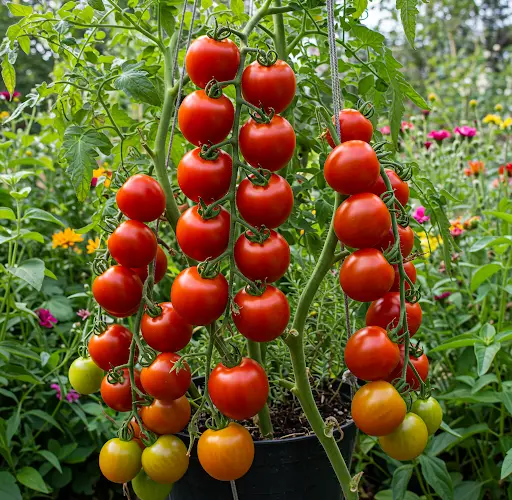Tomatoes are one of the most rewarding crops you can grow at home. Their rich flavor, vibrant color, and versatility in the kitchen make them a favorite among gardeners. The good news is that you don’t need a large garden to enjoy fresh tomatoes—just a sunny terrace, some containers, and a simple technique to maximize your harvest.
In this article, you’ll learn how to grow tomato plants on your terrace using an effective method that encourages more fruits with minimal space. Whether you’re a beginner or an experienced gardener, this approach is easy to follow and yields impressive results.
1. Choose the Right Tomato Variety
Not all tomato plants are created equal when it comes to container gardening. To get the most fruits in limited space, opt for determinate or dwarf varieties. These grow to a certain height and produce fruit over a short period, making them ideal for terraces.
Best varieties for terraces include:
-
Cherry tomatoes
-
Patio or bush tomatoes
-
Roma (plum) tomatoes
-
Dwarf heirloom types
Indeterminate varieties, which grow tall and produce fruit continuously, can also be grown but will need larger pots and strong support.
2. Selecting the Right Container
Tomatoes have deep roots and need room to grow. A small container limits their development and reduces fruit production.
Ideal container size:
-
At least 12–14 inches in diameter and depth for determinate varieties
-
15–18 inches or larger for indeterminate types
Use containers with proper drainage holes to prevent root rot. Grow bags, clay pots, or food-grade plastic containers all work well.
3. Use Quality Potting Mix
Soil quality plays a major role in fruit production. Regular garden soil tends to compact in containers and may lack nutrients.
Prepare your potting mix by combining:
-
2 parts high-quality potting soil
-
1 part compost or well-rotted manure
-
1 part cocopeat or perlite for aeration
This ensures good drainage, moisture retention, and nutrient availability.
4. The Key Tip: Deep Planting for Strong Roots
Here’s the special trick that encourages stronger plants and higher yields: plant your tomato seedlings deep, burying two-thirds of the stem. Tomato plants can grow roots along their buried stems, resulting in a more robust root system that supports better growth and fruiting.
How to do it:
-
Remove the lower leaves from the seedling.
-
Dig a deep hole in the container.
-
Place the seedling in at an angle, covering most of the stem.
-
Gently firm the soil around the plant and water thoroughly.
This deep planting technique strengthens the plant’s base and allows it to draw more nutrients and water, which translates to more flowers and fruits.
5. Provide Support Early
Tomato plants need support as they grow. Install a stake, tomato cage, or trellis immediately after planting to avoid damaging the roots later.
Training tip:
Tie the plant loosely to the support with soft twine or strips of cloth. Continue supporting the plant as it grows upward.
6. Watering and Feeding for Fruit Production
Tomatoes need consistent moisture, especially during flowering and fruiting.
Watering guidelines:
-
Water deeply when the top inch of soil feels dry.
-
Avoid overhead watering—water at the base to reduce the risk of disease.
Feeding tips:
-
Start feeding after the plant begins flowering.
-
Use a tomato-specific fertilizer or apply compost tea, banana peel liquid, or diluted fish emulsion every 10–14 days.
-
High-potassium feeds help boost flowering and fruiting.
7. Pruning for Maximum Yield
Regular pruning helps focus the plant’s energy on producing fruit rather than excessive foliage.
Steps:
-
Pinch off the suckers (small shoots that grow between the main stem and branches).
-
Remove any yellowing or damaged leaves.
For indeterminate varieties, prune regularly to manage their growth. Determinate types require less pruning, so be careful not to overdo it.
8. Terrace Setup and Sunlight
Tomatoes love the sun. A terrace with at least 6–8 hours of direct sunlight is ideal for healthy, productive plants.
Tips for terrace growing:
-
Arrange containers where they won’t be shaded by walls or other plants.
-
Use reflective surfaces (like white walls) to bounce light onto the plants.
-
In hotter regions, provide some afternoon shade to avoid sun scorch.
9. Harvesting and Enjoying Your Tomatoes
Tomatoes usually take 60–85 days from transplanting to harvest, depending on the variety. Harvest when they’re fully colored and slightly soft to the touch.
Pro tip:
Pick tomatoes regularly to encourage the plant to keep producing. Use them fresh in salads, sauces, or for sun-drying.
Final Thoughts
With just a bit of care and the right technique—especially deep planting—you can grow an abundance of juicy tomatoes right on your terrace. This method makes use of vertical space, enhances root development, and leads to vigorous plants that reward you with many delicious fruits.
Container tomato gardening is not only practical but incredibly satisfying. Give it a try and enjoy a steady supply of homegrown tomatoes all season long!



